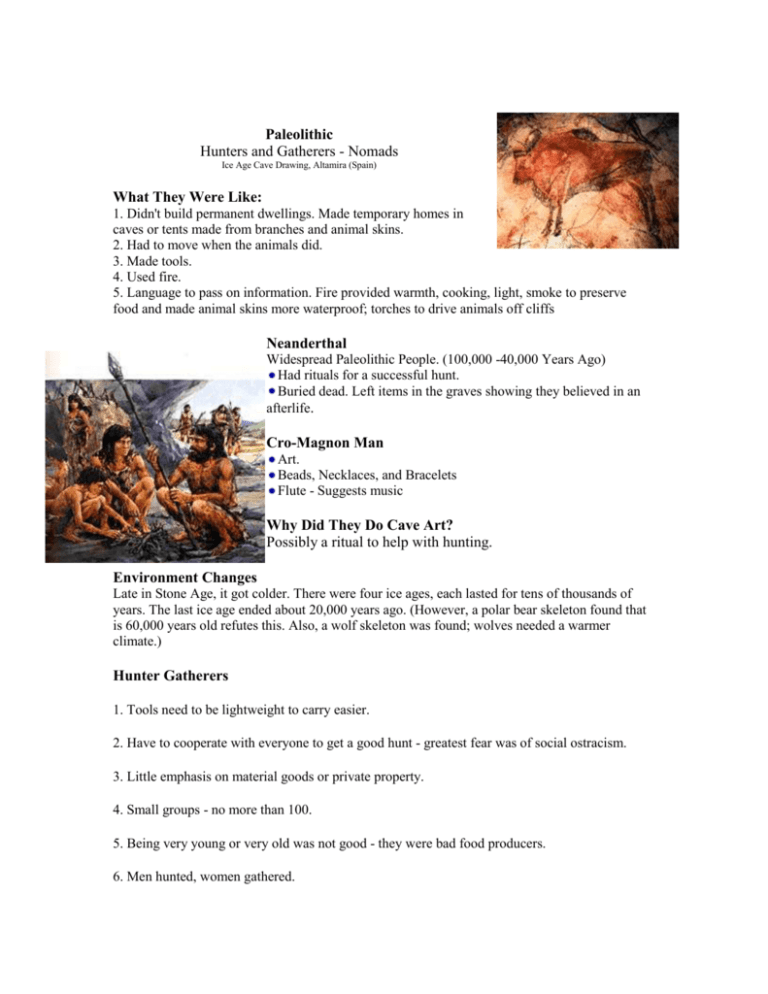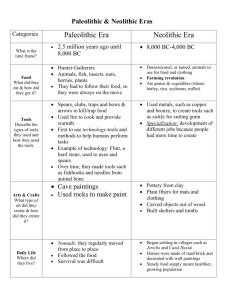File - Ms. Martinet`s history Class
advertisement

Paleolithic Hunters and Gatherers - Nomads Ice Age Cave Drawing, Altamira (Spain) What They Were Like: 1. Didn't build permanent dwellings. Made temporary homes in caves or tents made from branches and animal skins. 2. Had to move when the animals did. 3. Made tools. 4. Used fire. 5. Language to pass on information. Fire provided warmth, cooking, light, smoke to preserve food and made animal skins more waterproof; torches to drive animals off cliffs Neanderthal Widespread Paleolithic People. (100,000 -40,000 Years Ago) Had rituals for a successful hunt. Buried dead. Left items in the graves showing they believed in an afterlife. Cro-Magnon Man Art. Beads, Necklaces, and Bracelets Flute - Suggests music Why Did They Do Cave Art? Possibly a ritual to help with hunting. Environment Changes Late in Stone Age, it got colder. There were four ice ages, each lasted for tens of thousands of years. The last ice age ended about 20,000 years ago. (However, a polar bear skeleton found that is 60,000 years old refutes this. Also, a wolf skeleton was found; wolves needed a warmer climate.) Hunter Gatherers 1. Tools need to be lightweight to carry easier. 2. Have to cooperate with everyone to get a good hunt - greatest fear was of social ostracism. 3. Little emphasis on material goods or private property. 4. Small groups - no more than 100. 5. Being very young or very old was not good - they were bad food producers. 6. Men hunted, women gathered. World History - Prehistory Neolithic Age (About 9,000 Years Ago) How Early Humans Avoided Constant Wandering: 1. Farm and herd. Gather seeds from wild grasses and cultivate crops. Tame and domesticate animals - now there was a dependable food source. Do all of this by a river. Why along rivers? Fresh water for people, animals and crops, and it made trade easier because it is easier to travel on water. 2. Now, you can build a house. Others build houses close by, so they can be by the food source. 3. Social structure. Men hunt; women and children work the farm. 4. Artisans. Others, who don't want to farm, make things. Invented baked clay pottery, potter's wheel, looms for weaving, etc. 5. Barter system. How the farmers get the goods from the artisans and the artisans get food. What Were Their Houses Like? Rectangular, flat roofs, only entrance was through the top. For ease, the houses were built adjoining each other. Who Did They Worship and How? Goddess of Agriculture. Decorated building to her. Buried dead with food, showing a belief in the afterlife. How Did They Improve Agriculture? Plow (pulled by oxen), metal tools Now, How Would They Trade with People Far Away? Develop the wheel and the sail. What Were the Problems of Ownership? Needed a government. Usually a leader or chief - usually had a council to help make decisions. Where Was the First Town? Jericho, on the Mediterranean 7000 B.C. First Civilizations The earliest civilizations were in the river valleys of Asia and Africa. Earliest - Mesopotamia (5,000 years ago). Between Tigris and Euphrates Rivers Egyptian - Along the Nile Chinese - Along the Yellow River (New early site is being uncovered at this time in Honduras Paleolithic vs. Neolithic Paleolithic “paleo” = Neolithic “neo”= “lithic” = Nomadic = “lithic”= Neolithic Revolution Hunt or Farm Dwellings Permanent Structures Tools Clothes Art Sculpture Material Family Groups Choose ONE aspect that you think is the most significant difference between the people groups of the Paleolithic Age and the Neolithic age and explain why this change was important for the survival of the human population.








